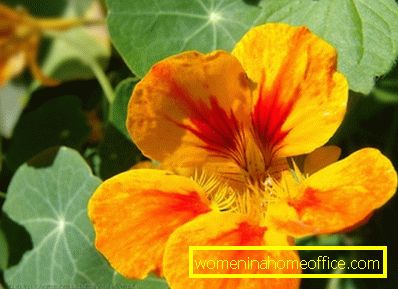Curly nasturtium
03-06-2018
Home and hobby
Curly nasturtium is grown in the garden. Another of its rather common name is capucine.The plant belongs to the family of capuchin. Originally from South America. It is used as a decorative view on flowerbeds, sidewalks, alpine slides, etc.
Description of the type nasturtium curly
- Curly nasturtium is a flowering bloom that is abundantly blooming country plant. This type of nasturtium in its biological and decorative properties resembles a different type of nasturtium, bush form.

- Stems develop quickly enough, they can grow from one and a half to three meters in length. It has round leaves on long cuttings. Depending on the lighting, the color of the leaves varies from light green to dark green.
- Flowers have a large winding, irregular shape. There are both simple and double flowers. The color of the petals is varied: yellow, pink, red. Flowers have a delicate scent. Blooms nasturtium curly from late June to frost.
Types of nasturtium curly
- Nasturtium (Capuchin) Lobby - high type of nasturtium. The length reaches 3-4 m. This species has many hybrid forms. Abundant flowering. However, this species has a drawback - it is too sensitive to poor lighting and cold, wet weather. This type is used for garden vases, window boxes, decorating balconies and trellises, etc.
- Canarian nasturtium (Capuchin canarian) - grows in length up to 3 m. The flowers of this species are small, gray-yellow. Blooms profusely, numerous. Very steady and unpretentious. Not bad transfers semi-shade location. Even the northern and northeastern places can not harm the Canarian nasturtiums. However, in the strong sun in this species, the lower leaves often fall. Flowering period - from July to the onset of cold weather.


Curly nasturtium: landing
- Planted nasturtium curling seeds. Sowing seeds is best in March or April. Do this as follows: plant 3-4 nasturtium seeds in a separate pot. Put all the pots in a warm greenhouse. In about a week, the seeds will germinate.
- Plant the seedlings in the open ground as soon as they are sufficiently formed. Ground from the roots do not shake off much, it is better to plant with a large earthy clod. In order not to damage the fragile root shoots.
- Observe the correct distance when planting seedlings in open ground - about 30 cm, not more!
- You can avoid planting seedlings. For this, seeds are sown immediately to a permanent place in May. 2-3 pieces at a distance from each other, as in the previous case.
Growing and caring for nasturtium curly
This type of quite demanding care. It is necessary to fulfill the conditions under which the plant will please its owners with good development and abundant flowering.
- Location This type is very thermophilic. Therefore, choose for it open sunny and warm places of your garden.

- The soil. For nasturtium curly needed loose soil. A mandatory requirement for the soil - fertility. However, overly fertilized land is unlikely to benefit the plant, quite the contrary. If the soil is heavy, it will also not have a very positive effect on the development of the plant. Indeed, then the vegetative system will grow strongly in it, and the curling nasturtium itself will be weaker than if it grew on lighter soils.
- Reproduction. Propagated by seeds.
- Watering. During the entire vegetative period of nasturtium curly, good, balanced, even better abundant watering is necessary.
- Feeding. It is necessary to feed the plant with liquid fertilizers during the whole growing season.
Observing all the rules for growing and caring for nasturtium curly, you can admire the bright beautiful flowering of very original flowers until the very frost almost from the beginning of summer. In addition, in calm weather, nasturtium will give your garden also a wonderful delicate scent.